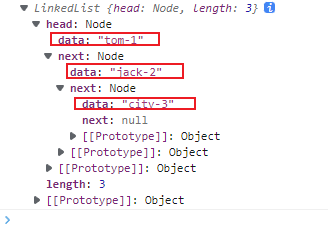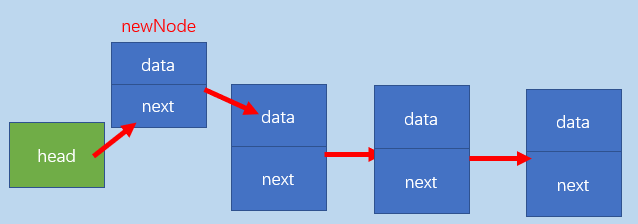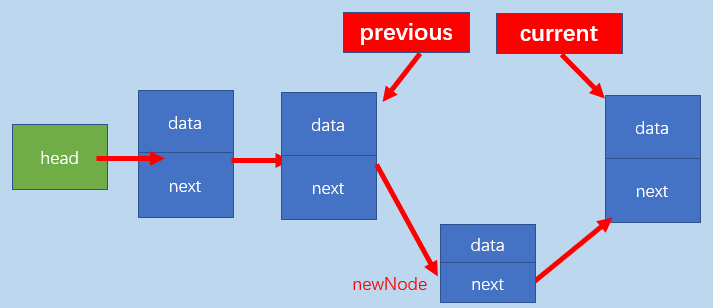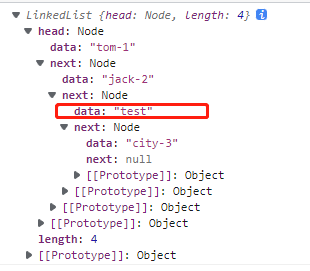二、单向链表(LinkedList )
单向链表
链表的简介
链表和数组一样,可以用于存储一系列的元素,但是链表和数组的实现机制完全不同。链表的每个元素由一个存储元素本身的节点和一个指向下一个元素的引用(有的语言称为指针或连接)组成。类似于火车头,火车头会连接一个节点,车厢(节点)载着乘客(数据),通过节点连接另一节车厢。

链表的优势:
- 链表中的元素在内存中不必是连续的空间,可以充分利用计算机的内存,实现灵活的内存动态管理
- 链表不必在创建时就确定大小,并且大小可以无限地延伸下去
- 链表在插入和删除数据时,时间复杂度可以达到O(1),相对数组效率高很多
链表的缺点:
- 链表访问任何一个位置的元素时,都需要从头开始访问(无法跳过第一个元素访问任何一个元素)
- 无法通过下标值直接访问元素,需要从头开始一个个访问,直到找到对应的元素
- 虽然可以轻松地到达下一个节点,但是回到前一个节点是很难的
链表中的常见操作:
- append(data):向链表尾部添加一个新的项
- insert(position,data):向链表的特定位置插入一个新的项,返回值为Boolean
- get(position):获取对应位置的元素
- indexOf(data):返回元素在链表中的索引。如果链表中没有该元素就返回-1
- update(position,data):修改某个位置的元素,返回值为Boolean
- removeAt(position):从链表的特定位置移除一项,返回值为被移除的数据
- remove(data):从链表中移除一项,返回值为Boolean
- isEmpty():如果链表中不包含任何元素,返回trun,如果链表长度大于0则返回false
- size():返回链表包含的元素个数,与数组的length属性类似
- toString():由于链表项使用了Node类,就需要重写继承自JavaScript对象默认的toString方法,让其只输出元素的值
封装单向链表
1.创建类
// 节点类
class Node {
constructor(data) {
// 数据
this.data = data
// 指向下一个节点
this.next = null
}
}
// 封装链表类
class LinkedList {
constructor() {
// 链表的头
this.head = null
// 记录链表的长度
this.length = 0
}
}
2.append(data)
向链表尾部追加数据可能有两种情况:
-
链表本身为空,添加的数据是唯一节点,需要把head指向节点
-
链表不为空,需要在链表最后面追加节点,并让链表最后一个节点指向此节点
代码实现
append(data) {
// 1.创建新的节点
let newNode = new Node(data)
// 2.判断添加的是否是第一个节点
if (!this.length) {
this.head = newNode
} else {
// 2.2不是第一个节点
// 查出最后一个节点
let current = this.head
while (current.next) {
current = current.next
}
// 在最后的节点的next上添加节点
current.next = newNode
}
// 节点长度加一
this.length += 1
}
测试
// 测试
const list = new LinkedList()
list.append('tom-1')
list.append('jack-2')
list.append('city-3')
console.log(list);

3.insert(position,data)

插入一条数据有三种可能发生情况
- position大于链表长度或者为负数
- return false
- position = 0
- 插在head后面

- position > 0
- previous和current分别指向需要插入位置前一个节点和要插入的节点
- newNode的next指向current ,previous的next指向newNode

// 指定位置插入数据
inster(position, data) {
// 1.对position进行越界判断
if (position < 0 || position > this.length) return false
// 2.根据data创建Node
let newNode = new Node(data)
// 3.插入newNode
// 插入数据有两种情况
// 第一种是position是0,插在head后
if (position === 0) {
newNode.next = this.head
this.head = newNode
} else {
// 第二种情况是position>0
let index = 0
let current = this.head
let preNode = null // 存放要插入位置的上一个
while (current) {
preNode = current
current = current.next
index++
if (index === position) {
newNode.next = current
preNode.next = newNode
break
}
}
}
// 4.length+1
this.length += 1
return true
}
测试
// 测试
const list = new LinkedList()
list.append('tom-1')
list.append('jack-2')
list.append('city-3')
list.inster(2, 'test')
console.log(list);

4.get(position)
// 获取对应位置的元素
get(position) {
// 1.越界判断
if(position < 0 || position > this.length - 1) return null
// 2.根据position获取对应的数据
let current = this.head
let index = 0
while (current) {
if (index === position) {
return current.data
}
current = current.next
index++
}
}
测试
// 测试
const list = new LinkedList()
list.append('tom-1')
list.append('jack-2')
list.append('city-3')
console.log(list.get(1)); // 结果:jack-2
5.indexOf(data)
// 返回数据在链表中的索引,如果没有,则返回-1
indexOf(data) {
// 定义变量
let index = 0
let current = this.head
// 开始查找
while (current) {
// 每次循环判断data是否相等
if (data === current.data) {
return index
}
// 不相等就current等于本身的next,准备下次循环使用
current = current.next
// 没循环一次 下标要+1
index += 1
}
// 循环完毕,没有找到相等的data
return -1
}
测试
// 测试
const list = new LinkedList()
list.append('tom-1')
list.append('jack-2')
list.append('city-3')
list.indexOf('tom-1')
console.log(list.indexOf(1)); // 结果:-1
console.log(list.indexOf('tom-1')); // 结果: 0
console.log(list.indexOf('city-3')); // 结果: 2
6.update(position,data)
// 修改某个位置的元素
update(position, newData) {
// 1.越界判断
if (position < 0 || position > this.length - 1) return false
// 2.根据position坐标获取要修改的数据
let current = this.head
let index = 0
while (current) {
// 2.1坐标相同,修改数据
if (index === position) {
current.data = newData
return true
}
// 2.2不相同,为下次循环做数据准备
current = current.next
index += 1
}
}
测试
// 测试
const list = new LinkedList()
list.append('tom-1')
list.append('jack-2')
list.append('city-3')
console.log(list);

7.removeAt(position)
// 删除链表中指定位置的数据
removeAt(position) {
// 1.越界判断
if (position < 0 || position > this.length - 1) return null
// 2.声明需要的变量
let index = 0
let current = this.head
let preNode = null // 当前节点的上一个
// 3.有两种情况,一种是position等于0,
if (position === 0) {
current = this.head
this.head = this.head.next
} else {
// 第二种情况是position不等于0
while (current) {
// 坐标相同
if (index === position) {
// 上一个坐标的next等于当前坐标的next,即跳过了当前节点的data
preNode.next = current.next
break
}
// 记录当前节点的上一个
preNode = current
current = current.next
index += 1
}
}
// 4.链表长度更新
this.length -= 1
return current.data
}
测试
// 测试
const list = new LinkedList()
list.append('tom-1')
list.append('jack-2')
list.append('city-3')
console.log(list);

8.remove(data)
remove(data) {
// 1.通过数据获取坐标,使用封装过的indexOf方法
let index = this.indexOf(data)
// 2.通过坐标删除链表中的数据,使用已经封装过的removeAt方法
return !!this.removeAt(index) // !! 转换成布尔型
}
测试
// 测试
const list = new LinkedList()
list.append('tom-1')
list.append('jack-2')
list.append('city-3')
console.log(list.remove('jack-2'));

9.sEmpty()
isEmpty() {
return !!this.length
}
10.size()
size() {
return this.length
}
11.toString()
实现流程:
- 主要是获取每一个元素
- 从head开始,遍历每一个节点,取出其中的data,拼接成字符串
- 最终将字符串返回
代码实现:
// 转换成字符串
toString() {
// 1.定义变量
let current = this.head
let res = ''
// 2.循环每一个节点
while (current) {
res += current.data + ' '
current = current.next
}
return res
}
// 测试
const list = new LinkedList()
list.append('tom-1')
list.append('jack-2')
list.append('city-3')
console.log(list.toString()); // tom-1 jack-2 city-3
整体代码
// 节点类
class Node {
constructor(data) {
// 数据
this.data = data
// 指向下一个节点
this.next = null
}
}
// 封装链表类
class LinkedList {
constructor() {
// 链表的头
this.head = null
// 记录链表的长度
this.length = 0
}
// 末尾添加一个节点
append(data) {
// 1.创建新的节点
let newNode = new Node(data)
// 2.判断添加的是否是第一个节点
if (!this.length) {
this.head = newNode
} else {
// 2.2不是第一个节点
// 查出最后一个节点
let current = this.head
while (current.next) {
current = current.next
}
// 在最后的节点的next上添加节点
current.next = newNode
}
// 节点长度加一
this.length += 1
}
// 转换成字符串
toString() {
// 1.定义变量
let current = this.head
let res = ''
// 2.循环每一个节点
while (current) {
res += current.data + ' '
current = current.next
}
return res
}
// 指定位置插入数据
inster(position, data) {
// 1.对position进行越界判断
if (position < 0 || position > this.length) return false
// 2.根据data创建Node
let newNode = new Node(data)
// 3.插入newNode
// 插入数据有两种情况
// 第一种是position是0,插在head后
if (position === 0) {
newNode.next = this.head
this.head = newNode
} else {
// 第二种情况是position>0
let index = 0
let current = this.head
let preNode = null // 存放要插入位置的上一个
while (current) {
preNode = current
current = current.next
index++
if (index === position) {
newNode.next = current
preNode.next = newNode
break
}
}
}
// 4.length+1
this.length += 1
return true
}
// 获取对应位置的元素
get(position) {
// 1.越界判断
if (position < 0 || position > this.length - 1) return null
// 2.根据position获取对应的数据
let current = this.head
let index = 0
while (current) {
if (index === position) {
return current.data
}
current = current.next
index++
}
}
// 返回数据在链表中的索引,如果没有,则返回-1
indexOf(data) {
// 定义变量
let index = 0
let current = this.head
// 开始查找
while (current) {
// 每次循环判断data是否相等
if (data === current.data) {
return index
}
// 不相等就current等于本身的next,准备下次循环使用
current = current.next
// 没循环一次 下标要+1
index += 1
}
// 循环完毕,没有找到相等的data
return -1
}
// 修改某个位置的元素
update(position, newData) {
// 1.越界判断
if (position < 0 || position > this.length - 1) return false
// 2.根据position坐标获取要修改的数据
let current = this.head
let index = 0
while (current) {
// 2.1坐标相同,修改数据
if (index === position) {
current.data = newData
return true
}
// 2.2不相同,为下次循环做数据准备
current = current.next
index += 1
}
}
// 删除链表中指定位置的数据
removeAt(position) {
// 1.越界判断
if (position < 0 || position > this.length - 1) return null
// 2.声明需要的变量
let index = 0
let current = this.head
let preNode = null // 当前节点的上一个
// 3.有两种情况,一种是position等于0,
if (position === 0) {
current = this.head
this.head = this.head.next
} else {
// 第二种情况是position不等于0
while (current) {
// 坐标相同
if (index === position) {
// 上一个坐标的next等于当前坐标的next,即跳过了当前节点的data
preNode.next = current.next
break
}
// 记录当前节点的上一个
preNode = current
current = current.next
index += 1
}
}
// 4.链表长度更新
this.length -= 1
return current.data
}
// 从链表中移除指定值
remove(data) {
// 1.通过数据获取坐标,使用封装过的indexOf方法
let index = this.indexOf(data)
// 2.通过坐标删除链表中的数据,使用已经封装过的removeAt方法
return !!this.removeAt(index)
}
// 判断链表有没有数据
isEmpty() {
return !!this.length
}
// 返回链表的长度
size() {
return this.length
}
}


